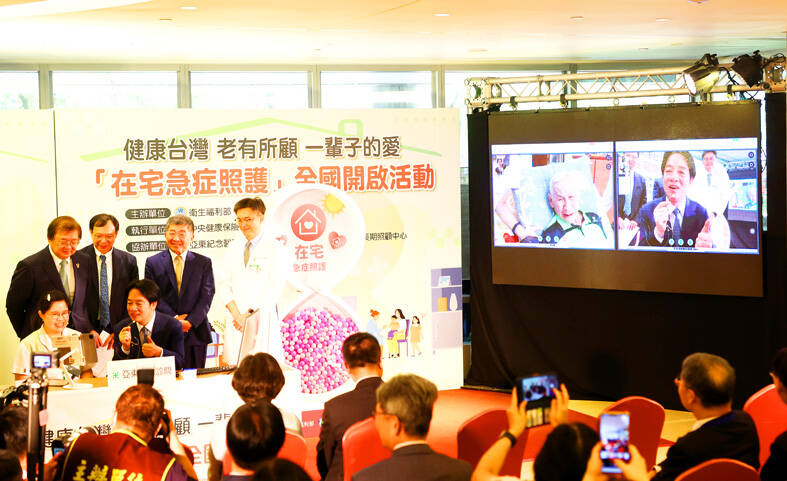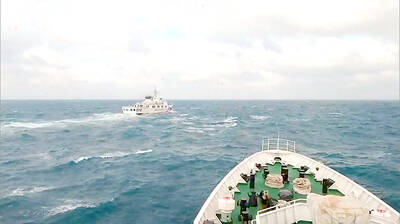President William Lai (賴清德) yesterday visited a hospital to oversee implementation of the “acute care at home” trial program after amendments to the Rules of Medical Diagnosis and Treatment by Telecommunications (通訊診察治療辦法) aimed at expanding telemedicine services took effect on Monday.
The amendments added five new categories of people eligible for telemedicine: those in a chronic care program, under hospice care, in correctional institutions or under disability care, or those receiving treatment for an illness or injury sustained in a disaster, an infectious disease or for other major incidents.
The pre-existing five categories of eligible people were those receiving post-acute care, long-term care, international medical care or home-based medical care, or people who have been admitted by a family doctor.

Photo: CNA
In all cases, they must either have received approval from the local health department or be included in the National Health Insurance bundled payment programs.
Lai yesterday visited Far Eastern Memorial Hospital (亞東醫院) in New Taipei City’s Banciao District (板橋) to observe the implementation of the new program.
Minister of Health and Welfare Chiu Tai-yuan (邱泰源) said Taiwan would become a super-aged society next year, meaning people aged 65 or older would account for more than 20 percent of the population.
The acute care at home trial program is expected to alleviate the burden caregivers face of having to take elderly patients to and from hospitals, by linking long-term care resources and bringing medical care to people at their homes or care facilities, Chiu said.
Lai, formerly a physician, said that when he was a resident doctor, some bedridden patients were brought by their family members to see him.
He said he also grew up in a remote township with limited medical resources, where doctors would send people medicine or voluntarily conduct free consultations.
That is why he wants to promote home-based healthcare services, Lai said.
The expansion of telemedicine services and the launch of the trial program can be seen as a milestone for Taiwan’s healthcare services, Lai said.
As technology advances, Taiwan must apply it to healthcare services to benefit the public, he added.
Demonstrating the telemedicine service, a nurse held a teleconsultation with a bedridden patient nicknamed Ah Hua (阿華). Lai stood to the side as a doctor encouraged Ah Hua to sit up and try to walk more often.
The program has teams of doctors, nurses, pharmacists and respiratory therapists providing integrated care to people who need antibiotic treatment for pneumonia, urinary tract infections or soft tissue infections, National Health Insurance Administration Director-General Shih Chung-liang (石崇良) said.
The patients can choose to be hospitalized or to receive home-based care using telemedicine, equipment to remotely monitor their vital signs and bedside testing, which would enable them to rest at home while receiving treatment, he said.
The trial program is expected to benefit about 5,400 people, he added.

Taiwan is gearing up to celebrate the New Year at events across the country, headlined by the annual countdown and Taipei 101 fireworks display at midnight. Many of the events are to be livesteamed online. See below for lineups and links: Taipei Taipei’s New Year’s Party 2026 is to begin at 7pm and run until 1am, with the theme “Sailing to the Future.” South Korean girl group KARA is headlining the concert at Taipei City Hall Plaza, with additional performances by Amber An (安心亞), Nick Chou (周湯豪), hip-hop trio Nine One One (玖壹壹), Bii (畢書盡), girl group Genblue (幻藍小熊) and more. The festivities are to

Auckland rang in 2026 with a downtown fireworks display launched from New Zealand’s tallest structure, Sky Tower, making it the first major city to greet the new year at a celebration dampened by rain, while crowds in Taipei braved the elements to watch Taipei 101’s display. South Pacific countries are the first to bid farewell to 2025. Clocks struck midnight in Auckland, with a population of 1.7 million, 18 hours before the famous ball was to drop in New York’s Times Square. The five-minute display involved 3,500 fireworks launched from the 240m Sky Tower. Smaller community events were canceled across New Zealand’s

The Ministry of Foreign Affairs (MOFA) yesterday said it is closely monitoring developments in Venezuela, and would continue to cooperate with democratic allies and work together for regional and global security, stability, and prosperity. The remarks came after the US on Saturday launched a series of airstrikes in Venezuela and kidnapped Venezuelan President Nicolas Maduro, who was later flown to New York along with his wife. The pair face US charges related to drug trafficking and alleged cooperation with gangs designated as terrorist organizations. Maduro has denied the allegations. The ministry said that it is closely monitoring the political and economic situation

‘SLICING METHOD’: In the event of a blockade, the China Coast Guard would intercept Taiwanese ships while its navy would seek to deter foreign intervention China’s military drills around Taiwan this week signaled potential strategies to cut the nation off from energy supplies and foreign military assistance, a US think tank report said. The Chinese People’s Liberation Army (PLA) conducted what it called “Justice Mission 2025” exercises from Monday to Tuesday in five maritime zones and airspace around Taiwan, calling them a warning to “Taiwanese independence” forces. In a report released on Wednesday, the Institute for the Study of War said the exercises effectively simulated blocking shipping routes to major port cities, including Kaohsiung, Keelung and Hualien. Taiwan would be highly vulnerable under such a blockade, because it